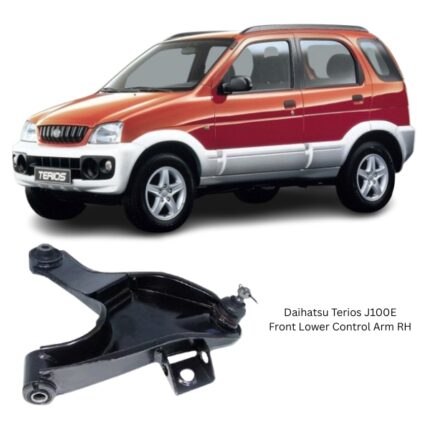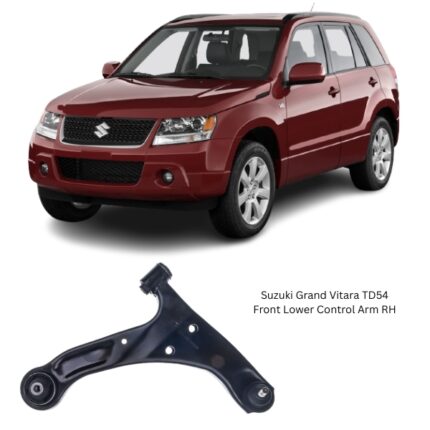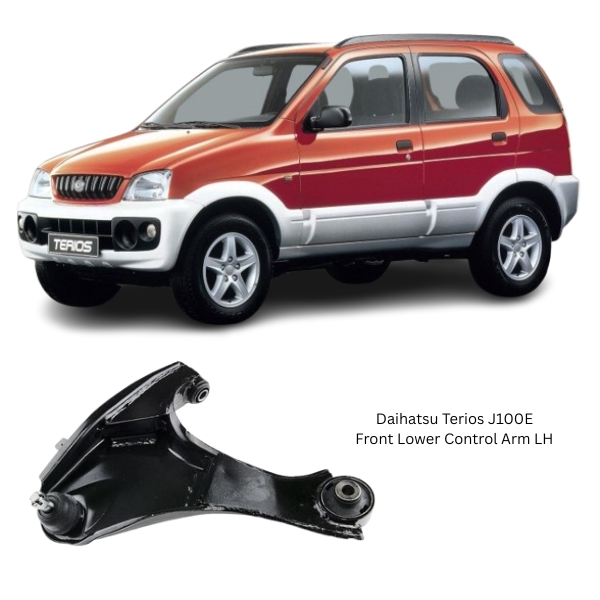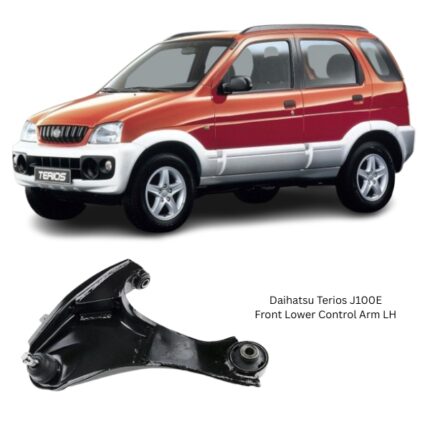Get Daihatsu Terios J100E Front Lower Control Arm LH 48069-87403 in Kenya
The Front Lower Control Arm Left Hand (LH) is a core component of a vehicle’s suspension system, playing a critical role in maintaining proper alignment, stability, and ride comfort. Specifically designed for the driver’s side (left-hand side) of the vehicle, this control arm acts as a connection point between the frame (chassis) and the wheel hub assembly, allowing controlled motion and providing support under varying road conditions.
A robust and precisely engineered Front Lower Control Arm LH ensures that the vehicle handles smoothly during turns, absorbs road imperfections effectively, and supports the structural integrity of the suspension geometry.
What Is a Lower Control Arm?
A lower control arm is part of a vehicle’s front suspension system, often paired with an upper control arm (in double-wishbone setups) or used in conjunction with a MacPherson strut design. It connects the lower part of the steering knuckle to the vehicle’s frame or subframe. The control arm allows the wheel to move vertically while holding it in proper alignment relative to the body of the car.
The arm generally includes two or more bushings at the inner (frame) side and a ball joint at the outer end (connecting to the steering knuckle). This setup ensures smooth articulation, reduced noise and vibration, and reliable support even under hard braking or aggressive driving.
Functions of the Front Lower Control Arm LH
The Front Lower Control Arm LH specifically supports the left front suspension, typically located under the driver’s seat area. Its main functions include:
-
Guiding and controlling the wheel’s up-and-down motion in response to road surfaces.
-
Maintaining proper wheel alignment geometry (camber and caster).
-
Absorbing and distributing road impact through rubber or polyurethane bushings.
-
Facilitating turning motions via a pivoting ball joint.
-
Providing stable support during braking, acceleration, and cornering.
Whether navigating smooth highways or uneven rural roads, this control arm helps preserve comfort, safety, and handling.
Design and Construction
Modern lower control arms are engineered using high-performance materials and precision manufacturing techniques to withstand dynamic loads and environmental stress. The LH control arm features a rigid frame structure, usually crafted from:
-
High-strength stamped steel – used in most economy and mid-range vehicles.
-
Forged aluminum – favored for performance and luxury models due to its lightweight properties and rust resistance.
-
Cast iron or alloy steel – common in heavy-duty applications, providing unmatched strength.
Key Components:
-
Bushings – Flexible inserts (typically rubber or polyurethane) located at the frame mounting points to absorb shocks and reduce noise/vibration.
-
Ball joint – A pivot point on the wheel side that allows the wheel to steer while moving vertically.
Many modern replacement arms come with pre-installed bushings and ball joints, simplifying installation and ensuring consistency with OE specifications.
Durability and Material Quality
Suspension components like the control arm endure a great deal of stress from daily driving, especially over rough or unpaved roads. That’s why the LH control arm is tested for:
-
Impact resistance
-
Tensile and compressive strength
-
Corrosion and wear resistance
-
Fatigue life under repetitive load cycles
To prolong service life, the control arm is typically finished with:
-
Powder-coated paint, for anti-rust protection
-
Zinc or phosphate coating, for environmental resistance
-
Welded or forged joints, for improved rigidity
Performance Benefits
Upgrading or replacing a worn Front Lower Control Arm LH brings several advantages:
✅ Steady Ride Control
Enhances the vehicle’s ability to absorb bumps and maintain stable tire contact with the road.
✅ Improved Steering Precision
Keeps suspension geometry intact for accurate and predictable turning.
✅ Noise and Vibration Reduction
Fresh bushings reduce the transmission of road noise and vibration into the cabin.
✅ Extended Tire Life
Proper alignment minimizes uneven tire wear caused by loose or failing control arms.
✅ Enhanced Safety
Prevents unexpected suspension failure that can compromise steering or stability.
Signs of a Failing Front Lower Control Arm LH
Due to its critical function and constant movement, the LH control arm is subject to wear and damage over time. Watch for the following signs:
-
Clunking noises when driving over bumps or during braking.
-
Vehicle pulls to one side, especially when braking.
-
Uneven tire wear, especially on the inner or outer edges.
-
Steering wandering or play.
-
Visible rust, cracking, or damage on the control arm or bushings.
-
Poor alignment or failure to maintain wheel tracking.
If any of these symptoms appear, it is essential to inspect and, if necessary, replace the control arm immediately.
Installation Information
Installing a new Front Lower Control Arm LH should be carried out by an experienced mechanic or technician, but competent DIYers may also handle the task with the correct tools and safety measures.
General Installation Process:
-
Lift the vehicle securely using a jack and jack stands.
-
Remove the front wheel on the left-hand side.
-
Disconnect the ball joint from the steering knuckle.
-
Unbolt the arm from the subframe at the bushing mounts.
-
Extract the old control arm and compare it with the new unit for fitment.
-
Install the new control arm, ensuring proper orientation and torque settings.
-
Reinstall the wheel and perform a full alignment.
Tip: Replacing both the LH and RH control arms at the same time can offer better ride balance and consistent performance.
Maintenance Tips
While control arms are designed to be low-maintenance, here are a few practices to extend their life:
-
Inspect during regular service intervals for signs of cracking or bushing deterioration.
-
Replace worn-out bushings or ball joints before they affect handling.
-
Keep suspension bolts torqued properly, especially after tire or alignment work.
-
Avoid aggressive off-roading or curbing, which can stress suspension parts.
Follow us on Facebook for more parts.





Reviews
Clear filtersThere are no reviews yet.